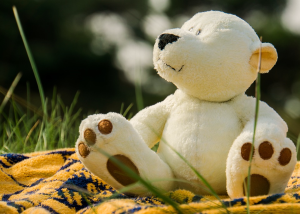 |
Medium – water involved |
 |
1-2 hours for the whole activity |
 |
Low |
 The aim of this is to get children thinking about why we choose certain materials for different objects. We adapted an idea from this great website and tried it with preschoolers from the lovely Orchard House Nursery in Tamworth.
The aim of this is to get children thinking about why we choose certain materials for different objects. We adapted an idea from this great website and tried it with preschoolers from the lovely Orchard House Nursery in Tamworth.
Introduction activity
Start with some different objects and put them in a cloth bag. Get children to reach into the bag and choose an object. Before they lift it out, get them to describe it. Some words you can prompt them with are…
You don’t have to put the objects in a bag, but it helps for getting children to focus on touch and texture rather than what the object looks like. This activity could also work well as a scavenger hunt. Go and find a crinkly object, a soft object etc.
The objects we chose were a wooden spoon, a metal spoon, a ceramic egg cup, a fluffy glove, a paper bag, a plastic toy and a swimming hat. With older children you can ask them what different objects are made from.

Teddy goes camping
The aim of this experiment is to work out which material is best to make teddy’s tent out of. It works best in the garden or on a large tray or towel as it involves water. You will need:
- 3 teddies
- Small watering can full of water
- Frame for a tent – You can built a simple one using bamboo sticks and tape
- Materials to cover the tent – (we use kitchen roll, cotton fabric and plastic sheeting cut from a rubble sack or bag-for-life)
The experiment
Cover the tent with the kitchen roll and tape the paper in place. Then start the story.
Three teddies decide to go camping. The first teddy made a tent out of paper. The teddy climbed inside and lay down to sleep.
In the middle of the night it started to rain! Oh no! (at this point, get one of the children to tip the watering can over the tent) What happens to teddy’s tent?
Poor teddy got wet!
Repeat the experiment with a bit of cotton sheet and plastic sheet. You should find that the cotton sheet isn’t as bad as the tissue, but it gets wet and eventually drips through. With the plastic, point out to the children that the water runs straight off.

The learning point from this experiment is that in our everyday lives, we use different materials for different things. Plastic is good for teddy’s tent because it’s waterproof. The rain runs straight off it.
This is a great introduction to some of the ideas they’ll meet in school during Key Stage 1. They will learn to identify different everyday materials such as wood, plastic and glass. They will also learn to describe physical properties of materials. Are they hard or soft, rough or smooth? What are different materials used for?
Going further…
In our session, we went a bit further to talk about some problems with materials and introduce our group to environment and recycling. You can explain to children that plastic is really useful for lots of different things because it is waterproof. But a bad thing about plastic is that it doesn’t rot down. If it ends up in a river or in the sea it will just keep floating around.
Keep the concepts fairly simple. With our group we said “if the plastic ends up in the sea, something might eat it”. What creatures live in the sea that might eat the plastic? The children had a lot of fun naming different sea creatures.

We wanted to introduce the children to the idea that plastic can float around in the ocean and swirl around in the currents. A lot of scientists study this by taking samples of the ocean and then building up computer models of where plastic is most concentrated. The most famous of these areas of high plastic concentration is in the North Pacific Gyre.
To introduce this in a simple way (and to create a lovely artwork in the process!) we painted a canvas with different rings of colour. We then collected lots of bits of coloured plastic, such as bottle tops. The children then glued the coloured plastic onto the picture to make this beautiful and powerful mural.
Page author: Zoe Schnepp

This work is licensed under a Creative Commons Attribution 4.0 International License.


